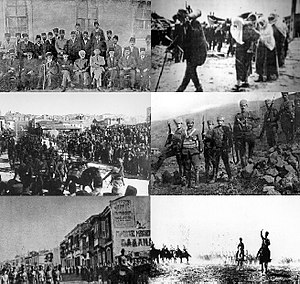
A | B | C | D | E | F | G | H | CH | I | J | K | L | M | N | O | P | Q | R | S | T | U | V | W | X | Y | Z | 0 | 1 | 2 | 3 | 4 | 5 | 6 | 7 | 8 | 9
This article's lead section may be too long. (June 2023) |
| Turkish War of Independence | |||||||||
|---|---|---|---|---|---|---|---|---|---|
| Part of the Revolutions of 1917–1923 in the aftermath of World War I | |||||||||
 Clockwise from top left: Delegation gathered in Sivas Congress to determine the objectives of the Turkish National Movement; Turkish civilians carrying ammunition to the front; Kuva-yi Milliye infantry; Turkish horse cavalry in chase; Turkish Army's capture of Smyrna; troops in Ankara's Ulus Square preparing to leave for the front. | |||||||||
| |||||||||
| Belligerents | |||||||||
|
Turkish Nationalists: Also:
|
Allied Powers: (in 1920) Supported by: (in 1921) | ||||||||
| Commanders and leaders | |||||||||
|
|
| ||||||||
| Strength | |||||||||
|
November 1920: 86,000 (creation of regular army)[18] August 1922: 271,000[19][note 1] |
1922: 200,000[21]–250,000[22][23] | ||||||||
| Casualties and losses | |||||||||
|
22,690 died of disease[30] 5,362 died of wounds or other non-combat causes[30] 35,000 wounded[29] 7,000 prisoners[31] Total: 83,052 casualties |
18,095 missing 48,880 wounded 4,878 died outside of combat 13,740 prisoners[32][33][note 2] 3,000+ prisoners[42] Total: 116,055 casualties | ||||||||
|
264,000 Greek civilians killed[43] 60,000–250,000 Armenian civilians killed[44][45] 15,000+ Turkish civilians killed in the Western Front[46] 30,000+ buildings and 250+ villages burnt to the ground by the Hellenic Army and Greek/Armenian rebels.[47][48][49][50][51] | |||||||||
|
Notes
| |||||||||
The Turkish War of Independence[note 3] (19 May 1919 – 24 July 1923) was a series of military campaigns and a revolution waged by the Turkish National Movement, after parts of the Ottoman Empire were occupied and partitioned following its defeat in World War I. The conflict was between the Turkish Nationalists against Allied and separatist forces over the application of Wilsonian principles, especially national self-determination, in post-World War I Anatolia and Eastern Thrace. The revolution concluded the collapse of the Ottoman Empire; the end of the Ottoman sultanate and the Ottoman caliphate, and the Republic of Turkey was declared in Anatolia and Eastern Thrace. This resulted in a transfer of vested sovereignty from the sultan-caliph to the nation, setting the stage for Republican Turkey's period of nationalist revolutionary reform.
| Part of the Politics series |
| Republicanism |
|---|
